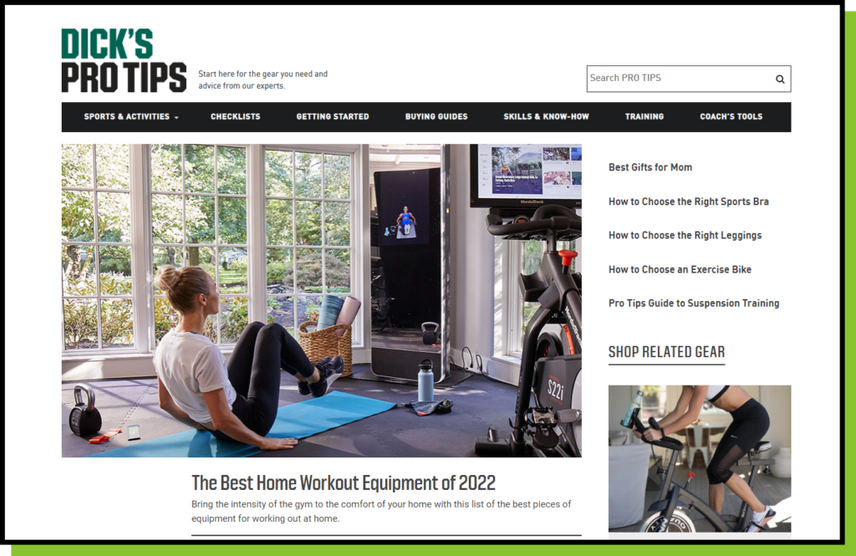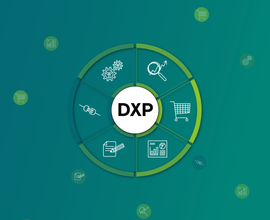Play Your Carts Right: Retail Strategies to Drive Conversions
Using these six tips, learn how to increase conversion rates in retail and run a successful omnichannel eCommerce retail strategy.
It’s no surprise that customer behavior has evolved drastically since the onset of COVID. Your customer’s expectations, wants, and priorities have changed to adapt to our new environment—as should your retail strategy.
These six tips will help power your eCommerce retail strategy to drive higher conversions in this new era. Ranging from customer experience insights to when to start planning your content strategy and more, you’ll find a wealth of new ideas to start implementing today.
TikTok goes the clock on your social media strategy
As brick-and-mortar shops faced large-scale closures during the pandemic, social media became even more influential on retail inspiration and purchases from users. Take TikTok, which led retail conversions among new women’s apparel trends in 2021. A standout example is the $29 IKEA Tote Bag that went viral in the US in 2021: since making its first appearance on the app, sales have skyrocketed across the country, increasing by up to 10x . Pageviews of the product on the website have increased by 100x, with the page being viewed more than 20,000 times in one day alone.
How did this video , from TikToker @prakritarahman , hook viewers? By showing that it's an essential staple for anyone on the go. The video demonstrated how much can comfortably fit in the bag (laptop, lunchbox, chargers) and highlighted its versatility—wear it as a backpack or shoulder bag. There's also a loop for your keys featured in the videos. It displays the bag for all its perks—a multifaceted, everyday bag.
Intimated by the thought of creating your first TikTok video? Don’t be. Follow these tips to get started:
- Include hashtags. They can help the TikTok algorithm decide who would be most interested in seeing your content. They can also get your content seen by users interested in a particular topic.
- Now the question—what are the best hashtags for your TikTok video(s)? First, look at what your competitors are using, along with what your audience is using. Tip: TikTok’s limit for captions is 100 characters.
- Sprout Social recommends using 3-5 hashtags so you’ll still have space to write an engaging caption.
The timing of your posts is vital and the times for highest engagement vary depending on the day of the week .
Altogether, these factors help you establish who your audience is and when they’ll most likely be online and searching for your content. You’ll be on your way to growing a follower count (and driving conversions) in no time.
When it comes to content, the calendar is your best friend: plan ahead
COVID has made consumers start shopping a lot earlier and with more agility. Keep these tips in mind when planning your content strategy:
- Start your content strategy a solid year in advance for major retail-driven holidays like Black Friday, Prime Day, Singles Day, and Cyber Monday.
- Leverage campaign landing pages throughout the year. For instance, try keeping your Black Friday page up all year with a ‘stay tuned’ message that directs people to other promotions or products. That way, you don’t lose SEO equity, and you make the most of a page with high traffic. Plus, you’ll get more products and deals in front of potential customers.
- In a related C3 session, Retail Strategies to Drive Conversions , Christine Bronzo , Sr. Manager of SEO at Fossil said: “COVID has disrupted how people search. See what people are searching for at different points in the year. How does it change? Your content needs to be fluid.”
What do we mean by fluid? The ability to adapt in real-time. Take Dick’s Sporting Goods : in response to COVID-19, the marketing team created a “Pro Tips” campaign that focused on supporting consumers as they shifted their workout routines to home. They built a “Dick’s Pro Tips” content hub, which focuses on delivering content that answered common questions and search terms like “best home workout equipment” and “how to choose an exercise bike.” By doing so, they were able to win out on top search phrases over competitors and see major organic traffic increases as a result.

If you build out your strategy ahead of time—and leave room for real-time marketing—you’re guaranteed to see real results.
Evergreen content is always “fresh”
Planning your strategy ahead of time also underlines the importance of evergreen content. Evergreen content, or search-optimized content continually relevant to your customer,is often overlooked. Some examples include:
- Ultimate Guides, like this one , that break down the best places to shop in NYC.
- Checklists provide value in an easy-to-consume and condensed way and stand as a great repurpose tool. Here's one that lists 14-points to launching an eCommerce site.
- Case Studies not only show real-world results to your audience but also shows off your work. Here’s an example that shows how Blinds.com migrated historical SEO data with the use of Conductor’s platform.
Add these pieces to a recurring maintenance calendar to ensure you make the most of high-ranking content that stays relevant. Tip: make sure to include updated product and external links, so it remains high in the SERPs.
Schedule out or plan these pieces throughout the year to fill in gaps between other big marketing pushes.
Another perk of implementing an evergreen content strategy? It will help you (and your team) avoid burnout. Planning ahead of time will give your content, social, and media teams proper notice and avoid last-minute surprises.
Get detailed AI-generated insights on how to best optimize your evergreen content for SERPs with Conductor’s Content Guidance. Take the guesswork out of your content workflow so you can create winning content with accuracy.
Some prime advice: don’t fear Amazon
While many retailers may not be able to compete with Amazon directly when it comes to rankingsRankings
Rankings in SEO refers to a website’s position in the search engine results page.
Learn more, driving traffic, conversions, or revenue from search engines—don’t think of them as your enemy.
If you’re still able to capture the second spot, you will still drive revenue, despite Amazon outranking your pages. Make your goal to rank in that second high-traffic spot on SERP to beat other direct (and indirect) competitors.
But that’s not your only option. There are special search resultSearch Result
Search results refer to the list created by search engines in response to a query.
Learn more types that you can strategically aim to capture through content creation. If you’re able to get a piece of content listed as a Featured Snippet for a top search (often referred to as “Position 0”), then there’s a great chance you’ll see a significant spike in traffic as a result. You can also try to win on specific types of search results like Popular Products .
It’s all about mindset: think customer-first
Think like your shopper, always. What do they want? How are they viewing your website and your products on a desktop? How about on mobile? Enacting this behavior, particularly when thinking about search, will give you a better sense of the consumer experience and encourage you to improve the journey. When experiencing your site through their eyes, consider factors like efficiency (you don’t want slow load times) and great product descriptions (so your customer won’t search elsewhere). Remember, your content needs to be fluid and from the lens of your consumer.
If you want to understand your customer's mindset, keywordKeyword
A keyword is what users write into a search engine when they want to find something specific.
Learn more and search behavior is a must. Keywords are ideas and topics that define what your content is about. When thinking about SEO, they’re the words and phrases that searchers enter into search engines, often called “search queries.”
Here are two Conductor case studies that highlight the importance of knowing what your customers are searching for and why identifying the right keywords is so critical to success:
After reviewing Google Search results, Kristi Dillman , Search Marketing Manager for insurance company Zurich North America, noticed that their product pages weren’t showing up on Page 1 of search results for key search phrases. This makes it fairly difficult for searchers, AKA potential customers, to find them. The reason? Many of their naming conventions didn’t resonate with their target audience and were too vague. Their pages were built around industry jargon like “historic property” and didn’t include essential terms their audience was searching for, like “insurance.” Working with Conductor, she updated title tags, headers, and added FAQ content to include top relevant search terms and those directly related to customer and broker needs. This led to a 52% increase in monthly traffic, and visibility doubled YoY.
Co-working space WeWork was having issues finding users’ search intent and identifying their customer's voice. With Conductor, they discovered key search terms like “collaborative workspace” and “coworking space” and incorporated those into the site. This change drove 150% YoY traffic growth.
Making what may seem like small changes to your site by incorporating in-demand keywords is a game-changer for your customer and competitive tracking. It doesn't hurt that it also helps drive conversions. Look to include these keywords in your:
- Page Titles and URLs
- H1 Tags
- Meta Descriptions
- Image Alt Text
- Content
Think of keyword research as market research and use it as such.
The value of SEO & schema
SEOs should advocate the value of SEO across the conversionConversion
Conversions are processes in online marketing that lead to a defined conclusion.
Learn more funnel and integrate it early on in the content and web development process. If you don’t have designated SEOs, you must make sure your marketing team recognizes the importance of SEO as an effective marketing channel and integrate it as part of their strategy from the get-go. It’s critical for helping increase awareness of your brand and has the power to introduce countless new potential customers to your website and product. SEO is driving more traffic to your website than you think, so make sure that the on-site experience is as positive and informative as possible. Without effective SEO, your retail strategy won’t produce the results you're looking for.
Along with keeping SEO top of mind, make sure your team has dedicated strategies for eCommerce SEO. This includes well-researched product descriptions, product and website copy informed by consumer searches, and a sound technical structure that ensures that search engines find your copy.
Different schema markups can also help by having relevant information such as reviews, up-to-date information, and expected shipping item(s). What do we mean by different schema markups? Think of it as structured dataStructured Data
Structured data is the term used to describe schema markup on websites. With the help of this code, search engines can understand the content of URLs more easily, resulting in enhanced results in the search engine results page known as rich results. Typical examples of this are ratings, events and much more. The Conductor glossary below contains everything you need to know about structured data.
Learn more around all things on the web. It allows a user—and search engines—to better understand the information on your site.
For eCommerce, these four schemas are winners:
- Product: A product type can describe both physical and digital products and can be used on product listing pages and the product page itself.
- Offer: This can be an offer to make a deal or see an exclusive deal.
- ImageObject: Your product will most likely include images to preview the product—make sure this ImageObject Type can help show that image as part of a result.
- Action: Your customer hitting that “Buy” button.
Schema.org offers an extensive list you can use when optimizing your content.
SEO is driving more traffic to your website than you think, so make sure that the on-site experience is as positive and informative as possible. Keeping your online store optimized and user-friendly is the key to remain competitive and continue to grow in this digital era.
To see SEO strategies that won the SERP and even more insights into the consumer market, check out Conductor's U.S. Retail Trend Report in 2021.







